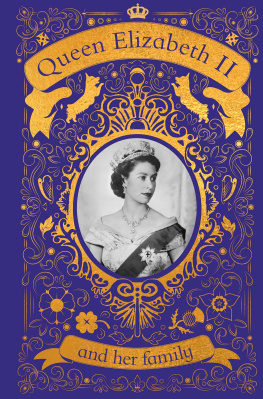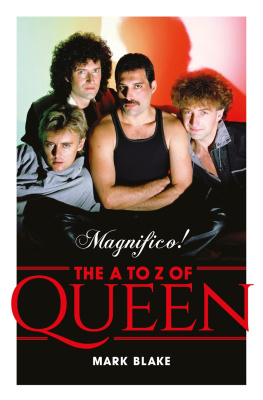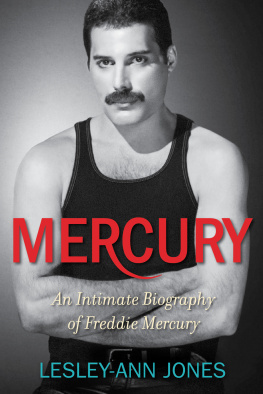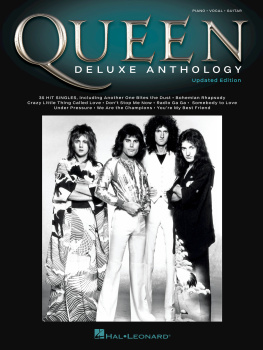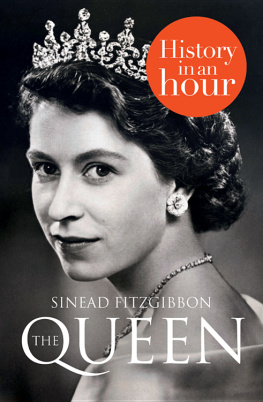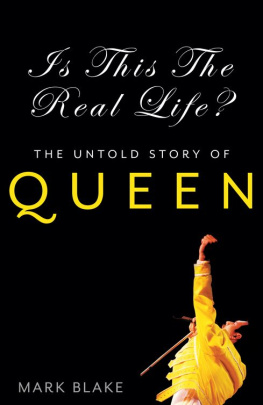Contents
Guide
T here is only one author name listed on the cover of this book but, as is so often the case with works relying on research and reference and recounting, there are many individuals to whom that one name is indebted. To those who spoke to me directly for the book, providing new insight on well-discussed topics and adding color to the story, and to those who provided crucial information, pictures, and advice, my sincere thanks: Brian May, Tim Staffell, Morgan Fisher, Howard Blake, Bruce Murray, Doug Bogie, Tony Stewart, Mark Grehan, Martin Skala of Queenconcerts.com, Peter Gifford, Alice Lorenzini (lunaelive.com), Davide Traversi and the Official Italian Fan Club, Andreas Voigts, Janis Davidson, Carol Demont, Owen Hopkin, Rupert White of Queen in Cornwall: youve all made this book much richer than I could have alone.
Everyone at Rowman & Littlefield and Backbeat, for your editorial support and hard work, particularly Paula, Carol, Barbara, Bruce, and John: thank you. Same goes to Robert Lecker, who was game enough to suggest I write this book in the first placeI valued your belief and enthusiasm from the very beginning.
My wonderful in-laws Stuart and Liz were kind enough to let me dog-sit in their mercifully silent and unbelievably comfortable house for long stretches while I was in the final stages of the first draft. My parents, who bought Queen CDs and guitar chord books when their youngest son pestered them, and my older brothers, who donated home-recorded mixtapes of Queens Greatest Hits (with The Muppet Show album on the other side), are the reason I am able to write about music today.
Finally, my love and everlasting puppyish gratitude goes to Emily, Wilson, and Roy, the family who had to put up with my writing this book for many months, accompany my crate-digging for original Flash Gordon LPs, work at our bookshop in my absence, and then smile and nod at my continual sounding out of deeply ephemeral theories around Queen trivia. I hope it wasnt too annoying for you.
A s this book was reaching the final stages of its first draft, I was constantly being forced to reconsider everything to be included. This was simply because Queen is an active proposition, and every news story, magazine interview, or red carpet Facetime punted out into online consciousness could potentially color our perception of any event from the bands history. But far from being a frustration, this stream of content merely confirmed something thats always been true about this most multifarious and flexible of musical behemoths: everyone has their own version of Queen. Inevitably, in many areas of this book, its possible to see the authors version much more clearly than others.
To assess the bands status today is, in a sense, very simple. In 2019, its clear that the release and subsequent awards season ubiquity of Bohemian Rhapsody has undoubtedly done the band more cultural favors than any of Roger Taylor and Brian Mays other recent projects under the Queen banner. Importantly, that success is ultimately due to nostalgia rather than a bold step into new creative territory. With Adam Lambert, Taylor and May still sell out huge tours and play the same arenas they would conceivably be playing were Freddie Mercury still alive and John Deacon still musically active. But again, this is all based on accumulated cultural importance, and the appetite for it remains undiminished as the bands fiftieth anniversary rapidly approaches. Indeed, at that point, there will no doubt be a majestic celebration of the bands worldwide impact.
But beneath the surface of Queen as a cultural artifact predicated on former glories, there is still the beating heart of what the band had always tried to do: to keep everything they made within walls of their own construction. May and Taylors hold on the brand (and it is most definitely a brand as well as a band) remains tight. For better or worse and regardless of how cool or uncool it might make them look, every associated album, concert, collaboration, and licensing deal is scrutinized. When you hear I Want It All on a TV advertisement for a furniture retailer, you know that this has been allowed to happen by those who have control of the brand.
I contacted a lot of people associated with Queen for this book, both historically and currently, and almost all of them had shared their stories before in some form or another as talking heads on a TV documentary or as part of a magazine oral history. As outlined in the introduction, the sheer volume of material available makes any truly new spin on the story very difficult to come by. I mention this not as an excuse for any shortcomings (I sincerely hope they are minimal) but rather to reinforce the idea that Queen is unwieldy and difficult to understand not because they are especially mysterious but because theres almost too much of them to go around. This is, in my view, both a strength and a weakness.
This final chapter is subtitled I Still Love You in a nod to Freddie Mercurys final words to the public in the video for These Are the Days of Our Lives and simply because that is how I feel about Queen. But the very nature of loving Queen as a band requires more forgiveness than one might require in the act of loving, say, ABBA or Kate Bush or the Wu-Tang Clan. A simplistic way of looking at it would be to conclude that some of the bands cheesy latter-day missteps are seen as triumphs by die-hard fans, and some of their murky and inaccessible early material is seen as off-putting by those coming to the band afresh. But, as with almost everything related to Queen, the truth is more complex. As this book has suggested, especially in the chapter on Hot Space, to be enthusiastic about Queen can seem at times a thankless task. Personally, I advocate an inclusive approach: if you love Queen at their best, you must at least try to understand them at their worst. For every moment of genuine musical togetherness, every miraculously choreographed flash of dry ice that swelled with the slide of a finger up a guitar neck, there is an equal and opposing moment of forehead-scratching despair, a collaboration with a forgotten boy band that smacked of nothing more than commercial gain.
These extremes run in parallel throughout the bands whole career. You can fool yourself into believing that the band had genuine underground and do-it-yourself credentials as they dragged their homemade kit around the country, but the goal of the band has always, always been maximum exposure. And by now, they are extremely good at achieving just that.
Brian May and Roger Taylor (and manager Jim Beach) continue to exercise control over the Queen empire with, were told, silent approval from John Deacon. There are plenty of well-written and well-argued critiques of why the ongoing activity of a band that contains only 50 percent of its original lineup feels queasy to many fans, but, on paper at least, its no more ghoulish or uncomfortable than the continuing careers of AC/DC or the Grateful Dead or the Who: its just that none of those bands happened to have Freddie Mercury as their singer. The graffiti on the walls outside Montreux Casino, like the graffiti on the benches in Viretta Park next door to the home where Kurt Cobain took his own life, shows decades later just how big a hole a singer can leave in the legacy of a band.
Many begrudge Queen their second coming, accusing them of opportunism. These accusations have a firm grounding: the financial benefits of their ongoing work are plainly enormous. As this section is being written, in May 2019, Queen + Adam Lambert are about to embark on another U.S. tour, with dates scheduled in 2020 for Korea and Japan and New Zealand and Australia. These are, again, massive shows. The audience remains. But again, the story changes at the last minute: in a recent interview with


